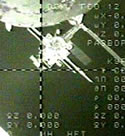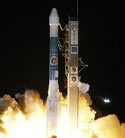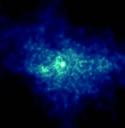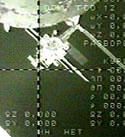
Image credit: Hubble
The newest image release from the Hubble Space Telescope is of the shredded remnants of Cassiopeia A, a star that went supernova more than 10,000 years ago – the youngest known supernova in our galaxy. Debris has formed into thousands of cooling knots of gas and dust, and will eventually supply new star systems with heavier elements such as oxygen and sulphur.
Glowing gaseous streamers of red, white, and blue ? as well as green and pink ? illuminate the heavens like Fourth of July fireworks. The colorful streamers that float across the sky in this photo taken by NASA’s Hubble Space Telescope were created by one of the biggest firecrackers seen to go off in our galaxy in recorded history, the titanic supernova explosion of a massive star. The light from the exploding star reached Earth 320 years ago, nearly a century before our United States celebrated its birth with a bang.
The dead star’s shredded remains are called Cassiopeia A, or “Cas A” for short. Cas A is the youngest known supernova remnant in our Milky Way Galaxy and resides 10,000 light-years away in the constellation Cassiopeia, so the star actually blew up 10,000 years before the light reached Earth in the late 1600s.
This stunning Hubble image of Cas A is allowing astronomers to study the supernova’s remains with great clarity, showing for the first time that the debris is arranged into thousands of small, cooling knots of gas. This material eventually will be recycled into building new generations of stars and planets. Our own Sun and planets are constructed from the debris of supernovae that exploded billions of years ago.
This photo shows the upper rim of the supernova remnant’s expanding shell. Near the top of the image are dozens of tiny clumps of matter. Each small clump, originally just a small fragment of the star, is tens of times larger than the diameter of our solar system.
The colors highlight parts of the debris where chemical elements are glowing. The dark blue fragments, for example, are richest in oxygen; the red material is rich in sulfur.
The star that created this colorful show was a big one, about 15 to 25 times more massive than our Sun. Massive stars like the one that created Cas A have short lives. They use up their supply of nuclear fuel in tens of millions of years, 1,000 times faster than our Sun. With their fuel exhausted, heavy stars begin a complex chain of events that lead to the final dramatic explosion. Their cores rapidly collapse, releasing an enormous amount of gravitational energy. This sudden burst of energy reverses the collapse and tosses most of the star’s mass into space. The ejected material can travel as fast as 45 million miles per hour (72 million kilometers per hour).
The images were taken with the Wide Field and Planetary Camera 2 in January 2000 and January 2002.
Original Source: Hubble News Release





